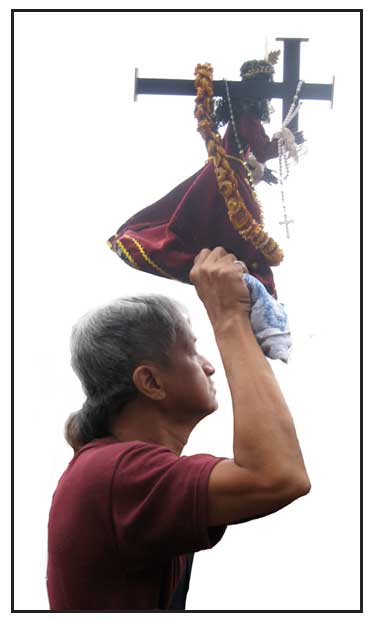| Also see: January 2012 Nazarene Festival | |
January 9, 2011 The feast of the Nazarene is none of these. The last few years, I have watched it on tv, The past few years I have wanted to see it up close, |
In May 31, 1606, the Black Nazarene, a life-size wooden sculpture, was brought by galleon from Mexico by the first group of Augustinian Recollect friars. Enroute, as folk tradition relates, the statue was damaged in a ship fire, and it original white complexion was burned into a charred discoloration, henceforth, earning the name "Black Nazarene." Referred to as the Nuetro Padre Jesus Nazareno de Qiuiapo, It has been enshrined in the Minor Basilica of the Black Nazarene in Quiapo since the latter part of the 1700s. The story of its survival is in itself miraculous. As it has survived the galleon ship fire, it has also endured other great fires that ravaged Quiapo in 1791 and 1929, the earthquakes of 1645 and 1863, and the World War II bombing of Manila in 1945. Devotion to the BlackNazarene is a yearlong celebration, with weekly novena masses held every Friday, starting the first Friday of the year, and January 9 celebrates the feast of the Black Nazarene. |
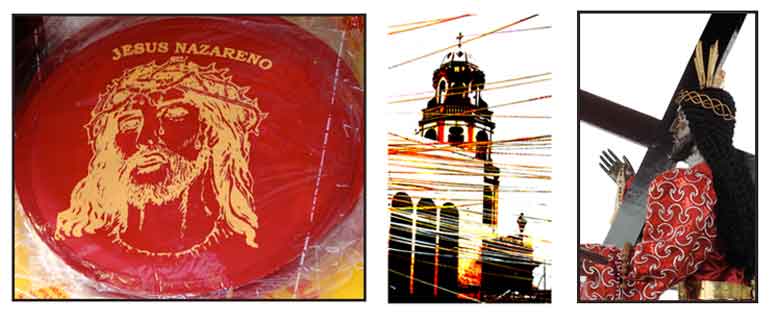
Friday, January 7, Quiapo was abuzz. This is the third year for Luneta as venue |
The image carried in the processions consists of the original body of the Nazarene connected to a replica of the head. The original head portion remains on a replica of the body enshrined in the basilica altar. In the 2007 feast, in celebration of the Black Nazarene's 400-year history, the original head and body were used in the procession.
|
The panata, so essential to the devotion of the Nazarene. Perhaps, from a promise inherited from parents long gone. From a favor granted, a prayer answered, or a desperate need. The promise, the vow, the panata, perpetual, so deeply personal, that beckons them back, year after year. One lady, now 36 years old, tending her baby, gladly shared her story. . . a panata started by her parents, when she was a child. She has been coming since, every year for the past 27 years. By late afternoon, the park ground in front of the grandstand filled up fast. Footpaths snaked around camped spaces, Nazarene floats, and a scattering of commerce. Food stalls, balloon vendors, Nazarene trinkets, statuettes galore. A profusion of floats and ground altars, old and new, simple and ornate. Prayer candles sold and lit. Bare-chested men waiting for theNazarene image As night descends, streetlamps light up the ephemeral village of devotees, as thousands of candles |
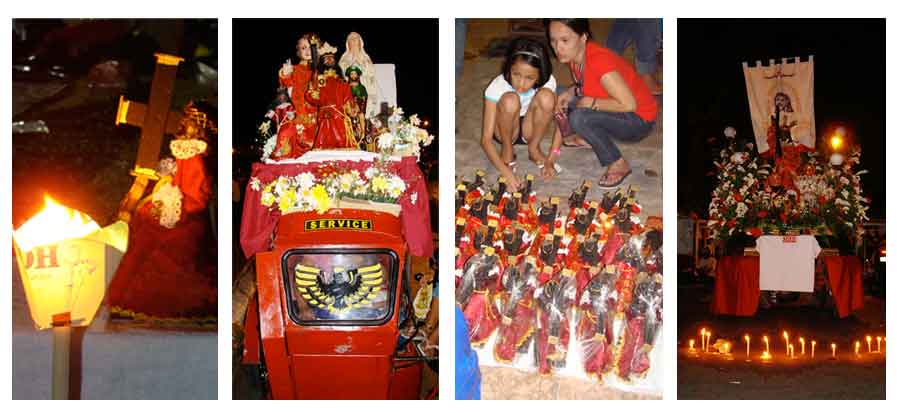 |
|
Floats, big and small, mechanized, drawn, push-pulled or shouldered, stood waiting, along sidewalks, suffering the reeking stench of overflowed portable toilets. Many stood to watch, a safe distance away, far back from the fences and the barriers, many with their Nazarene statues clasped in their arms or held high above their heads, hopeful that even from afar their Nazarene would be blessed and empowered, The faithful from all walks of life, who came to join in the celebration of the Nazarene, the women and the elderly with their sustained "panatas." Men, wishful, but without the youth and strength to be participant in the dangerous and exhaustive demands of the Nazarene procession, watching from afar. Many risked proximity to the procession avenue, the curious, myself included, and the youth, armed with digital and cell phone cameras jostling for vantage points, by the fences, railings, lampposts and barriers. To be a little closer, to catch a better glimpse. I found, what I thought was a safe place, by a lightpost, on a safe side of up of a metal fence rail. The crowed roared as the Nazarene started its descent from the grandstand. A difficult short journey, down a series of steps and turns, each successful maneuver met by roars and cheers from the crowd. So slowly it made its way to the ground. Then. . . suddenly, the waves of people. First, ripples. . . then, surges. . . The cramped landscape of devotees started to part, a Red Sea of the masa, pushing to the side, parting, making way as the Nazarene moved forward. People started rushing, pushing to the fence, to seek safety and shelter on the other side. Climbing on each other to get over the fence. The fence started to lean. There was a short attempt to hold the fence. The other side pushing it against the oncoming crowd. A woman pushed against my back, pushing me to the fence. There were a few moments of panic and uncertainty, thinking the wall would collapse on me anytime, to be trampled on by the advancing herd of frenzied devotees. I managed to disentangle myself, perhaps through the grace of angels, and joined the women and older devotees at their safe distance. |

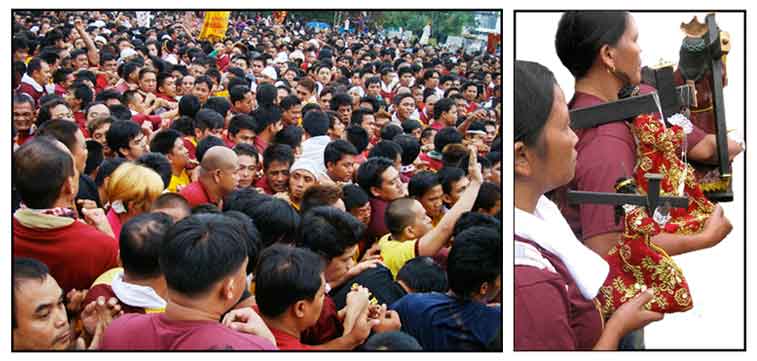
And from a safe distance, I watched the Nazarene go by. |

| I left soon after. Sleepless, weary, and overwhelmed by the stench that wafted about. The procession would take another ten hours to Quiapo. I took with me three days of impressions, images, conversations, and a deeper appreciation of the Filipino's religiosity. Of his "panata." It is a true Filipino celebration. One incredible window to its religious culture. And certainly, not one for the faint of heart. |
• |
| by Godofredo U. Stuart Jr. |
| The Black Nazarene Festival |
| Additional
Sources and Suggested Readings (1) A Study on Filipino Culture: THE DEVOTION TO THE BLACK NAZARENE OF QUIAPO by M. M. Aguinaldo, Ed. D., MMA Publications / A wonderful historical and field guide to Quiapo and the Black Nazarene culture. |
Also read: |
| BACK TO • THE INTREPID TRAVELER |


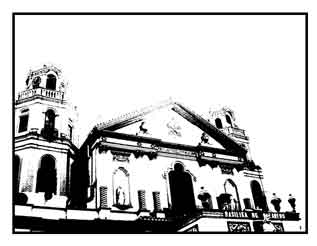
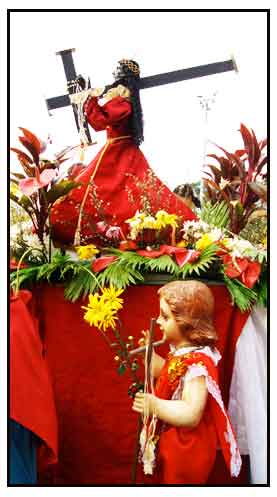
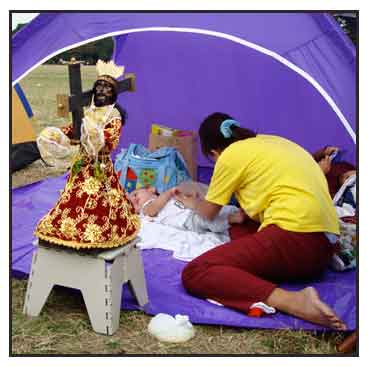 The early birds were staking their spots
The early birds were staking their spots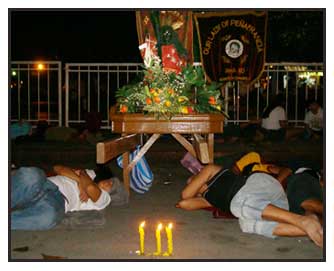 In the grandstand, the Nazarene statue received the unending line of faithful
In the grandstand, the Nazarene statue received the unending line of faithful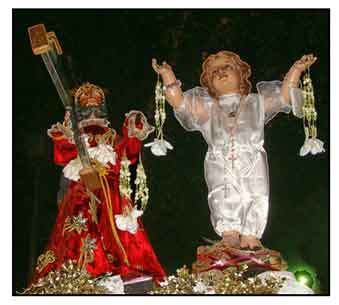 At the break of dawn, Luneta was astir.
At the break of dawn, Luneta was astir.